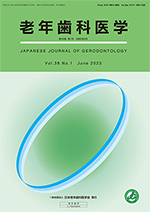Volume 39, Issue 4
Displaying 1-8 of 8 articles from this issue
- |<
- <
- 1
- >
- >|
Review Articles
-
2025Volume 39Issue 4 Pages 186-192
Published: 2025
Released on J-STAGE: April 25, 2025
Download PDF (3761K) -
2025Volume 39Issue 4 Pages 193
Published: 2025
Released on J-STAGE: April 25, 2025
Download PDF (467K) -
2025Volume 39Issue 4 Pages 194-195
Published: 2025
Released on J-STAGE: April 25, 2025
Download PDF (809K) -
2025Volume 39Issue 4 Pages 196-201
Published: 2025
Released on J-STAGE: April 25, 2025
Download PDF (1947K) -
2025Volume 39Issue 4 Pages 202-207
Published: 2025
Released on J-STAGE: April 25, 2025
Download PDF (1133K)
Original Articles
-
2025Volume 39Issue 4 Pages 208-215
Published: 2025
Released on J-STAGE: April 25, 2025
Download PDF (1504K) -
2025Volume 39Issue 4 Pages 216-224
Published: 2025
Released on J-STAGE: April 25, 2025
Download PDF (1164K)
Health Activity Report
-
2025Volume 39Issue 4 Pages 225-233
Published: 2025
Released on J-STAGE: April 25, 2025
Download PDF (3865K)
- |<
- <
- 1
- >
- >|
